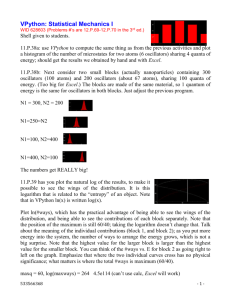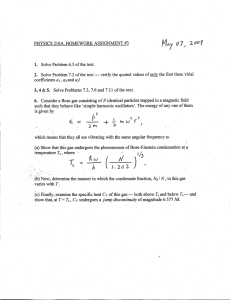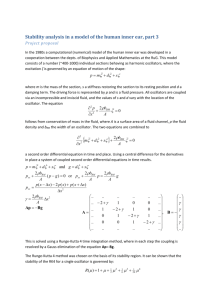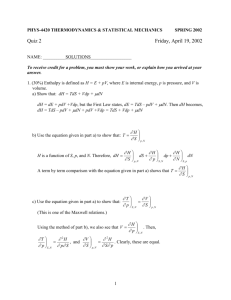4f 3 OSCILLATORS RESEARCH LABORATORY OF ELECTRONICS
advertisement
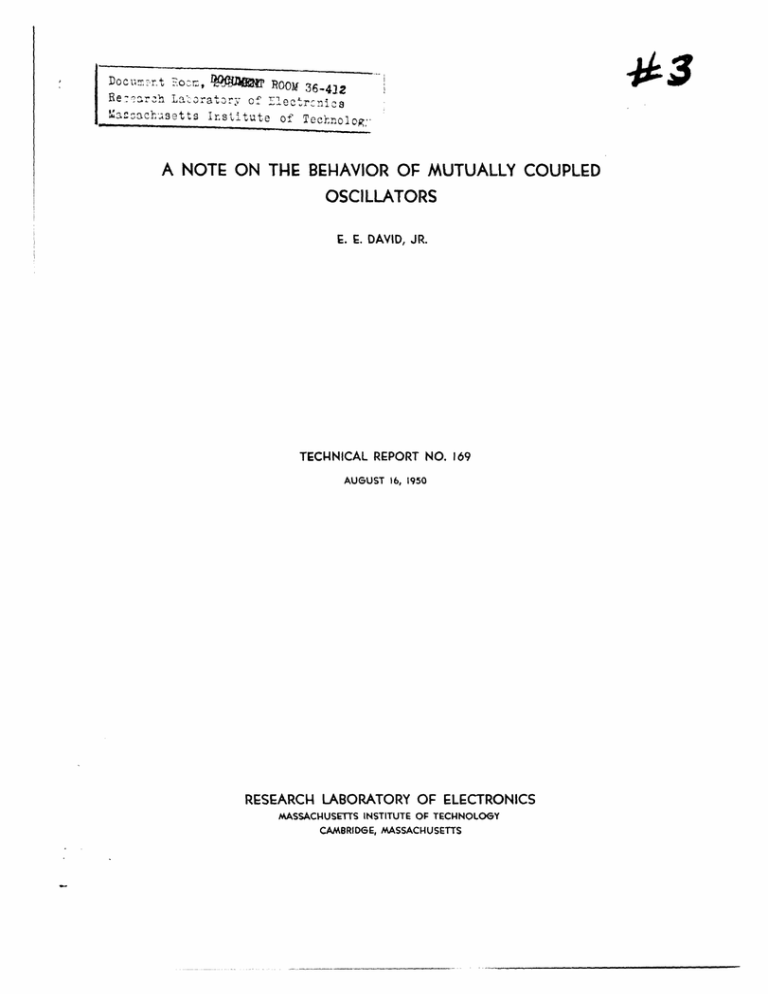
4f 3
Documz, t Eor,
~B
ROOM 36-412
Re-3~rh Laoratryof alectrcnic
Masachasett
s Irstitute of Technolog,;
A NOTE ON THE BEHAVIOR OF MUTUALLY COUPLED
OSCILLATORS
E. E. DAVID, JR.
TECHNICAL REPORT NO. 169
AUGUST 16, 1950
RESEARCH LABORATORY OF ELECTRONICS
MASSACHUSETTS INSTITUTE OF TECHNOLOGY
CAMBRIDGE, MASSACHUSETTS
.·--.-·
-·111___-.).11.
__
1_
_
~
1I^C_
__
II__
J·
I
MASSACHUSETTS
INSTITUTE
OF TECHNOLOGY
RESEARCH LABORATORY OF ELECTRONICS
August 16, 1950
Technical Report No. 169
A NOTE ON THE BEHAVIOR OF MUTUALLY COUPLED OSCILLATORS
E. E. David, Jr.
This report is based on work contained in a Doctoral
thesis in the Department of Electrical Engineering.
Abstract
The operation of an arbitrary number of oscillators mutually coupled into an arbitrary number of loads is discussed.
By utilizing the oscillator Rieke diagrams, the
scattering equations of the interconnecting network, and the constraints furnished by
the passive loads, the behavior of such a system may be predicted.
practically important cases are discussed:
Two simple, but
(1) two oscillators operating into a matched
parallel junction, and (2) the dual of this arrangement.
The operation of these systems
is critically dependent upon the oscillator spacing relative to the interconnecting network, although the tolerances on these spacings are not severe.
Dissimilarities between
the oscillators are not an important factor.
_I
I__
_ _I_
A NOTE ON THE BEHAVIOR OF MUTUALLY COUPLED OSCILLATORS
Introduction
There are practical and theoretical limitations on the power output obtainable from
a single oscillator. These limitations are particularly severe when one considers the
microwave region, for there the physical geometry of the device becomes increasingly
important. The cathode area, for instance, is determined by factors other than the
total desired emission current, which may be quite large, so large, in fact, as to
require current densities greater than those obtainable from practical emitting surfaces.
Nonetheless, great progress has been made in the production of large power at short
wavelengths.
The maximum output available from a single tube, however, is quite
insufficient for many purposes. In applications such as the linear electron accelerator
and very high power radar transmitters, it is desirable to operate two or more oscillators
into a single network so that their powers combine in an additive fashion. One suspects
immediately that this problem is closely akin to the oscillator synchronization problems
considered in Technical Report No. 63 (1). It is, however, much more involved, for
here each oscillator supplies a locking signal to each of the others. In addition, the
network used for the interconnection affects the problem in an important way. A general
solution, then, would be highly complex and is unnecessary for most purposes. We can
show that the general problem is soluble and then carry out the solution for two simple
but practically important cases. The results of this analysis may be used to predict the
more involved cases.
1.
The General Case of N Oscillators Operating into an M Terminal-Pair Network
Before considering some practically important cases of mutually-coupled oscillators,
it would be satisfying to examine the most general situation. If such an examination
shows that a unique solution is possible, one may use with confidence the results of
simplified analyses to draw certain conclusions about the more complex cases. Suppose
that N oscillators are operating into an M terminal-pair network; that is, there are N
oscillators and M-N passive loads (these may or may not be frequency-sensitive). The
network itself, assuming linearity, may be completely characterized by a set of M independent equations containing 2M independent variables. One possible set of these
equations is
b
= Sl
a l
b 2 = S2la
bM = Slal
where
+ S12a 2 + S13a3 ·
+ S1NaN + S(N+l)a N+ 1
.
S1Ma M
+ S22a2
2
+ S23a3 · . + S2NaN + S2(N+l)aN+1
a+
SZaZ + SM 3 a 3
S
+ SMNaN + SM(N+l)aN+i1
.
all other a's
Ij
all other a's = 0
aL
-1-
+ S2Ma
.
M
+ SMMaM
(1)
is the scattering coefficient for the i t h terminal-pair with respect to the jth terminalpair, and a. and b. are the incident and reflected waves respectively for the i t h terminal1
1
pair. In order to obtain a solution, M additional relations are needed. These are
provided by the constraints relating a i and b i . For the M-N passive loads, the constraints
take the form
N+ 1 = bN+ 1 rN+l1
aN+2 = bN+2 FN+2
aM
where r i = Z i - 1/Z
= bM rM
(2)
+ 1 is the reflection coefficient of the load at the it h terminal-pair
i
and Z i is its impedance relative to the impedance of the line.
The constraints imposed
by the N oscillators are contained in the Rieke diagrams and may be represented functionally by
bl = alR 1
b2 = aR2
bN =aNRN
(3)
Suppose that in such a system the only information available is the unperturbed frequency
W1 of one oscillator (hereafter referred to as No. 1) and the synchronized frequency of
the system, w.
bl
S 12a2 + S13a3
=
S l la
S21a
By substituting Eq. 2 into Eq. 1 and transposing, there results
l
-SNlal
=
2
= -
N
+
+ S22a2
S23 3
+ SNZa+SN3 a
)lal
N+=1
-S(
= SM2 2
+ Sl(N+l) aN+'..+S1MaM
S2NaN
+ S2(N+) aN+1
.. SNNN
3.
S(N+1)2
a
+ S(N+1) 3 a 3 '
+
-SMlal
.
SNaN
(N+1) (N+ 1)-
+ SM3a3 ....
+ SM(N+ )aN+
M+SZMaM
+ SN(N+1) aN+1. .+SNMaM
' S(N+ 1)NaN
rN
aN+l
' S(N+I)MaM
SMN N
.
[MM
mmaM
M
(4)
Now since oscillator No. 1 is operating at frequency o, a and b have a restricted
range of values, which are specified by the appropriate frequency line on the Rieke
diagram.
There is, on each of the other Rieke diagrams, a corresponding locus, which
is related to the first by Eqs. 4. In addition, these equations specify the ratios
-2-
__
_
bi/bll
and ai/all. This condition likewise determines a locus on each Rieke diagram. The
intersection of the two loci on a Rieke diagram specifies the operating point, providing
the ratio Ibi/bll (or lai/all ) and i = bi/a at that point correspond to the same al and
bl. Once the operating point for each oscillator has been located, the relative tuning
and power output of each is determined. It is possible, of course, that there is no
operating point which satisfies the conditions. This means that the initial assumptions
of 1 and w are not possible ones. However, this situation arises only if the difference
I w1
w-I is quite large. Results of this type may be used to establish the limits of the
locking band.
Further, one may use similar procedures to establish operating conditions when
sets of information other than the one discussed above are available. For instance,
the tuning of each oscillator and the operating frequency of the system desired might
be known. In any case, it has been shown that there are 2M independent variables
involved, and these are related by 2M equations. Thus a solution is possible.
2.
Normal Parallel Operation of Two Similar Oscillators
The operation of two oscillators, identical except for their relative tuning, into a
single load is usually accomplished by use of a circuit which places the tubes in parallel.
Such a circuit may be a transmission line tee or an H-plane waveguide tee junction.
Usually the load arm is made to have a characteristic impedance half of the main line
connecting the oscillators. Further, in order to make the oscillators appear truly in
parallel, they should be located an integral number of half-wavelengths from the tee
reference planes.
Under such conditions the oscillators are said to operate in a "normal"
fashion.
IDEAL
~~IDEAL
IDEAL
Figure 1 shows an equivalent circuit which
be used to analyze the normal situation.
From this circuit, the scattering equations are
IDEAL
:I
-.
Emay
bt
bl
2 al
1
1
+2
2 a2
2 a3
b2 =
2
1
-12
al-2
1 a + /f
-2 a
/ -I
Fig.
b3
1
3
f ___
+
2
2
2
In practice, the passive load is usually matched to its line, making a 3 - 0. If this is
the case, Eqs. 5 become
bl
b
=
b
=2
1
2 al
,
1
1
1
2 al2
a2
al + -
-3-
a2
2
a
.
(6)
It is seen immediately that the condition b 1 = - b 2 must be satisfied regardless of the
values of a l and a Z.
Stated in another way, this condition means that the reflected
powers of the oscillators must be equal if they are to operate at the same frequency.
Let this condition be incorporated in either of the first two Eqs. 6; there results
a
a
1-
1i
Note
fj
=-±--
b,2
fr·
2
(7)
.-
and r2 are complex variables and may be written r
= R1 + j
1
and rZ =
+
jI?.
Then Eq. 7 becomes, after separation of the real and imaginary parts
R
R
+ I2
+ 2 =0
+
=
(8)
.
Now Eqs. 8 must be satisfied at the operating point; however, these conditions carry the
stipulation, imposed by the passive network, that the reflected waves be equal.
This
proviso, as well as Eqs. 8, must be applied to the Rieke diagrams.
As an aid to the computation, contours of constant R/ rJ Z and I/
in the reflection coefficient plane.
1rf
will be plotted
These, of course, will be the same in both the I'
and r 2 spaces and are a set of orthogonal circles.
Figure 2 shows the unit circle of the
reflection space with the orthogonal set plotted thereon.
Consider then the contours of constant frequency and reflecter power shown in Fig. 3.
Such a plot is representative of an idealized reflex klystron (3) and will be used as the
Rieke diagram of both oscillators in the computation.
Note the diagram is symmetrical
about the center frequency line; this, in general, is not the actual configuration.
analysis, however, will be affected in detail only by asymmetries.
The
Now upon super-
posing Figs. 2 and 3 it is seen at once that the R/ Ir12 = - 1.0 circle is the locus of
points satisfying both Eqs. 8 and stipulation of equal reflected powers.
Any two points,
r1 and ri, lying simultaneously on this locus and the same reflected power contour
represent possible operating points for the two oscillators.
The frequency contour
passing through each of these points determines the relative tuning of the oscillators.
Just how this is accomplished may be seen by considering Fig. 4, which shows the rl
and r 2 spaces with the operating locus and frequency contours.
Typical operating points
for synchronized operation are 01 and 02' lying respectively on the frequency contours
W1 + x22 and w2 - o22 where w1 and w2 are the oscillator center frequencies (frequency
into a matched load) and are determined by the relative tuning. Now since the tubes are
synchronized, o =
operating points
1
+
22 =
Z - W2
2
' or w2 - W1 = 222 and, in general, for any two
w2 W1
Wii + jj
(9)
where wii and wjj are the frequency deviations of the contours passing through the points.
-4-
II
-
tl
c. 4
0
C)
Q)
0
a,
0^
00
,
tD
-4 O
a)
d:
o
C )
0
Wa
Ca)
Uo
-o
o
u~
-5-
Q
The synchronized frequency is
w
1
+
ii
=
(10)
2-jj
This discussion makes the assumption that when an oscillator is tuned over the range
indicated on its Rieke diagram, this diagram is not changed except for the absolute
frequency of the contours. All available evidence indicates that this assumption is
quite good for physical and electron-beam tunings, but may not be good for electronic
tuning, such as large reflector voltage changes in a reflex klystron (3).
Now a complete picture of normal parallel operation may be constructed. If both
oscillators are tuned to the same frequency, they operate at the point r = 0 (matched
As either or both oscillator tunings are varied so that 1w
2 - wJI increases, the
operating points move outward on the circular loci, the value of 2 - w1 and w at any
load).
time being given by Eqs. 9 and 10.
Returning to Figs. 2 and 3, the maximum value
of this difference, still maintaining synchronism, for this case is greater than 40 Mc.
In general, this value is determined by the factors which become important in the "sink"
region such as the series oscillator coupling impedance.
Note that if the operating locus
actually follows a circular path at large reflection coefficients,
an infinitely large value.
That is,
1w2 - w1 1 could assume
at the point r = - 1, the load admittance consists of
an infinite susceptance and, hence, may " pull" the oscillator frequency an infinite
amount. Actually, of course, even though the load at the oscillator output terminals
may approximate a short circuit closely, the series coupling impedance places a lower
limit on the effective load impedance, hence on the maximum-frequency pulling.
Thus,
in this region the shape of the locus is altered by factors not included in this analysis,
and the frequency deviation introduced by an infinite susceptance at the output terminals
determines the synchronization bandwidth.
There remains one additional matter to be discussed, namely that of the power available from the system.
lator.
Figure 5 shows constant power output contours for each oscil-
Since the microwave junction is essentially lossless, it may be seen that the load
power is the sum of the individual oscillator powers.
Once the operating points have
been determined, these powers, and hence the load power, are immediately calculable.
]
Also, the latter decreases sharply when 1w
becomes large; this characteristic is
2 - ol
to be expected quite generally.
3.
Anomalous Operation of Two Similar Oscillators
When the oscillators are not located at the tee reference planes, or an integral
number of half-wavelengths from them, the operation is changed quite drastically.
An
extreme example of this sort occurs when the spacing is an odd number of quarterwavelengths.
This condition results in operation of the "anomalous" variety.
The analysis may be carried out exactly as for the normal case.
However, the
Rieke diagram of Fig. 3 must be referred to the tee reference planes.
°
In order to
accomplish this, the diagram should be rotated 180 , following Smith Chart computations.
-6-
i
Again considering Figs. 2 and 3, it
is seen that the operating locus is a
circle, but displaced, on the Rieke
diagram, 180 ° from the one previously
discussed (see dotted locus in Fig. 4).
Thus the operation is entirely similar
except in two important respects:
(1) the synchronization bandwidth is
greatly reduced (7 as compared to
> 40 Mc); and (2) each intersecting
frequency contour now crosses the
locus twice, giving two sets of possible
operating points for each tuning of the
oscillators.
In order to resolve this
ambiguity, it is necessary to examine
each point with respect to stability.
o80
The angle of the reflection coeffiFig. 5
Power output contours.
cients for the oscillators may be
written
O1 =
rl -
and
il
02 =
(11)
r -- i
where r is the angle of the reflected wave at the tee terminals and i is that of the
incident wave. From the condition b = - b 2 , imposed by the junction, it is seen that
r 1I=r
r2z +
iT;
so by subtracting Eqs. 11 and substituting
01
-0
i
=
i
1
(12)
+
or differentiating with respect to time
d .i
d+.i
t-H
,V A
-
''2~1-
(13)*
This equation states a fundamental law as illustrated in Fig. 6, which shows a vector
representation of the oscillator outputs.
the quantity,
Aw2 - -1-
Relative motion of the two vectors determines
If the angle between the vectors is to increase (dy/dt > 0),
*The approximation involved here is a rather subtle one. Specifically, a change of frequency corresponds to the derivative of the phase angle of the total voltage (vector sum
of incident and reflected voltages) rather than the derivative of the phase of the incident
voltage alone. For most conditions, however, the magnitudes of these derivatives are
not greatly different, and for all points inside the unit circle (incident wave > reflected
wave) they will have the same sign, which will be our major concern.
7
Wj
+Wii
INCREASING
FRUENCY
\
/
Locus
/
W
2 -wil
/
/
0 8,
02
I
I c
', I
Fig. 6
Fig. 7
Aw2 must be greater than Aw 1 , making A
- A
1
> 0 and inversely.
Consider Fig. 7
which shows the operating locus and two sets of operating points illustrating the ambiguity.
Suppose now that the oscillators are subject to a perturbation, such as might
result from noise modulation of an electrode. Under these conditions, the frequency
contours on which 01 and 02 lie shift to some new position, as indicated by the dotted
If the oscillators are to take up the new steady-state operating points,
loci in the figure.
the angle 01 -
2
must decrease.
Hence dy/dt = Aw 2 - Awl < 0 by the previous argument.
Now when the frequency contours shift, 01 finds itself in a region on the Rieke diagram
where the frequency is greater than before the shift; thus Awo < 0. For point 0 2 the
opposite is the case, so A 2 < 0. Then the condition A 2 - Aw1 < 0 must certainly be
satisfied, and the oscillators assume the new steady-state condition. A similar examination of points 0 and 0 show that A 2 - A1 should be greater than zero, while actually
this is not the case, since the signs of aw and Aw1 remain the same as for 01 and 02
Hence points 0
and 02 are unstable, stable operation occurring at 01 and 02. For
stability in general, then, the sign of hAy- A 1, as determined by both the angle 01 - 0
and the position of the locus on the Rieke diagram, must be the same.
Quarter-wavelength spacing, therefore, results in a rather unusual condition.
Specifically, when the two oscillators are tuned to the same frequency, they work into
unity reflection coefficient (open circuit). As I 2 - wl is increased, the operating points
move on a circular path toward smaller reflection coefficients.
The locking bandwidth
is determined by the frequency contours tangent to the locus. Also, the power available
under these conditions is quite small, as may be seen by considering Fig. 5. In fact,
when identically tuned, the oscillators give zero output.
This anomaly is caused, quali-
tatively, by phase shifts introduced through the lengths of transmission line.
normal conditions and identical tuning, 01
of the two generated waves, is zero.
0 2 = r so that i
-
i,
Hence reinforcement results.
With
the relative phase
With anomalous
conditions and identical tuning, 01 - 02 = 0, so i - i = r and destructive interference
Therefore, no voltage appears across the load and no power is delivered.
is produced.
4.
General Parallel Operation of Two Similar Oscillators
Thus far the extreme examples of parallel oscillator operation have been considered
in detail. One asks immediately about operation in the transition region between these
-8-
extremes. More specifically, one would like to know the details of the operating loci
when (1) the spacing of each oscillator from the tee reference planes is not an integral
number of quarter-wavelengths, and (2) when the oscillators are asymmetrically spaced
with respect to the junction.
Consider, then, the case of both oscillators located the same distance, d, from the
tee and having the physical and electrical distances identical. That is, frequency sensitivity of the transmission line lengths is neglected. In order to determine the loci
it is first necessary to refer the Rieke diagrams to the tee reference planes. This may
be accomplished by rotation of the diagrams an appropriate amount with respect to the
reflection coefficient plane. The loci may then be found through a point-by-point examination of Figs. 2 and 3. Again, each pair of points on the locus must satisfy the conditions
imposed by the junction, namely Eqs. 8 and equal reflected powers. This procedure has
been carried out for seven different spacings ranging from zero to quarter-wavelength.
These loci are shown in Fig. 8. Those for spacings of quarter- to half-wavelength are
mirror images of the ones shown, since the Rieke diagram is symmetrical with respect
to the center frequency contour. Several facts are to be noted. Firstly, the bandwidth
of synchronization is strongly dependent on the spacing. Figure 9 shows the manner of
this dependence. Secondly, portions of the loci lie outside the unit circle, indicating
there are points at which one oscillator absorbs more power than it delivers. Operation
of this sort occurs on the dashed portions of the loci in Fig. 8. These parts are extrapolations of the data; an exact evaluation would require the "load characteristic" of the
oscillator, that is, information about its output and frequency at points where the output
wave is smaller than the reflected wave. Only points inside the unit circle were used
in calculating the bandwidth values shown in Fig. 9. Lastly, in several cases, two sets
of points correspond to the same frequency intersections. These ambiguities may be
removed by utilizing the stability criterion presented in Sec. 3*. Regions of unstable
operation are indicated by double lines in Fig. 8. Thus it is seen that no drastically
new aspects of behavior are revealed. The transition from normal to anomalous
operation is a systematic one. Finally, the line-length tolerances for normal operation
are not severe in practical applications.
One must note that the single loci indicated in Fig. 8 are a special case in which the
locus of both oscillators coincide. This situation exists only when the spacings relative
to the tee are equal or differ by an integral number of half-wavelengths. In all other
cases, two loci will be necessary to describe the system. The simplest condition of
this type occurs when the spacings are respectively nX/2 + x and mX/2 - x where m and
n are integers, not necessarily equal, and x is the deviation from integral half-wavelength
This criterion, as presented, does not apply to operating points outside the unit circle.
It may be made pertinent to these cases if we determine the appropriate sign of /C 2
A Cl(in Eq. 13). This may be found by examining the vector diagram formed by the
incident, reflected, and total voltage at the oscillator terminals for each specific case.
-9-
____111__111111·__1I
-
I
IC-
--I I
=-=
FREQUENCY RELATIVE TO CENTER FREQUENCY (MC/SEC.)
STABLE REGION OF OPERATING LOCUS
UNSTABLE REGION OF LOCUS
Fig. 8 Operating loci for line spacings nX/Z to nX/2 +
/4.
I
I
m
d- WAVELENGTHS
Fig. 9 Locking bandwidth as a function of oscillator spacing.
10-
spacing.
Again appropriately rotating the Rieke diagrams and satisfying the junction
conditions, the operating loci are found to be circles, passing through the point
= 0
and tangent to the unit circle respectively at points X/4 + x and k/4 - x (see Fig. 10).
Stability of operating points on dual loci is determined exactly as formerly.
In other
cases of unsymmetrical spacing, the loci shapes are distorted and shifted about on the
Rieke diagram much as loci 2 through 6 in Fig. 8.
bring no drastic changes in the operation.
will alter the discussion in detail only.
will be somewhat distorted.
5.
These considerations, however,
Similarly, an unsymmetrical Rieke diagram
In particular, the circular loci presented here
Series Operation of Two Similar Oscillators
Having considered the parallel operation of two oscillators, it is pertinent to examine
the dual case, that of series operation.
Oscillators may be placed in series by use of a
branched transmission line or an E-plane waveguide tee junction.
Usually the branch
or load line has twice the characteristic impedance of the line connecting the two oscillators.
An equivalent circuit for this type junction is shown in Fig. 11.
The scattering
equations as calculated from this circuit are
1
b1 =
1
1
+a
1
_2
a3
aZ +
1
2
a3
b 3 = Z al +
(14)
a2
180
90
00
=
o
UNSTABLE REGION
Fig. 10 Operating loci f or asymmetrical spacing.
-11-
____1__111_
1
I_
IDEAL
IDEAL
I:Afo
bz
c
<4
VT :1
p
IDEAL
a0
*= bz
e
b3
Fig. 11
Fig. 12
Equivalent circuit of an idealized series
junction.
Phase relationships during
normal parallel operation.
Again assuming that the passive load is matched to its line or that a 3 = 0, it is seen
that b 1 = b 2 . Continuing the development as before
RI
1
+
Rz
2 = 0
-2=0
1
+
2
=0
(15)
These are identical to Eqs. 8 for the parallel case except for the sign of the sum of the
real parts.
Hence, it is seen immediately that the locus for series operation with
oscillator spacing d is the same as for parallel operation with spacing d + X/4. Hence,
for normal operation with series connection the oscillators should be placed an odd
number of quarter-wavelengths from the tee reference planes.
In a similar manner,
the entire discussion in Secs. 2, 3, and 4 may be applied to this case.
6.
Phase Relationships during Normal Operation
It is of interest to compute the relative phase of oscillators during normal operation.
This information, of course, is available for any specific case from the circle diagrams
previously presented.
However, one would like to know explicitly the dependence of the
phase upon oscillator parameters.
ating locus.
Consider, then, Fig. 12 showing the normal oper-
Now the distance d is d = 61/2, and
Irl=
2 X 1/2 sin 61/2 = sin d.
Also,
note that the locus is a contour of constant load conductance; hence by the oscillator
operating equations, the electronic conductance and susceptance are likewise constants.
Then in the equation
=
only B and
+
may change.
B
Along the operating locus, therefore, the load susceptance
is related to the frequency in the following manner
-12-
i
I
2 Qext (
WC
Qe
B
)
(16)
o
where wC is the center frequency.
Also along the locus, d = tan- 1 B/2, or
d = tan l[
Qext
C)]
o
Now, note from Fig. 12 and Eq. 12
y= 26
-
180
6
i
i
- .
2
r
+
1
or
4i 2 --
i
1
-61
and
_
Q_io
-
_i-sin
sin
=
-
dd sin
sin
an I
-
C)
1ex
ext
or
2
where the relation,
X-
c
orpi
2 tan 2
1
= 1/2(X1 -
-i
1[Qe1xh(
~2
)
=
2o
2 ) ' has been used.
(17)
Equation 17 allows the evalu-
ation of phase sensitivity and tuning tolerance as a function of oscillator bandwidth.
7.
Practical Considerations
In most practical applications of mutually coupled oscillators, the center frequencies
are made as closely equal as possible.
Under such conditions, it is desired that the
oscillators each operate into a matched load.
For the systems just presented, this is
the case so long as normal or near-normal operation is maintained.
This fact may be
verified by noting that all such operating loci have a stable point at r = o, corresponding
to
1 -
c2 = 0.
Such results were derived assuming the oscillators identical.
the oscillators in question will deviate from this assumption.
In practice,
What will be the effect of
this deviation ?
It will be shown that when asymmetries between the oscillators exist, they will not
work into matched loads even when tuned to the same frequency.
Further, it will be
seen that this effect is not large and may be compensated by altering the characteristic
impedances of the tee arms.
In orderto show these things, we will assume that the
matched condition exists and find the conditions imposed by the junction.
The scattering equations for a junction may be found from equivalent circuits such
as shown in Figs. 1 and 11.
Considering only the series junction (the development for
parallel junctions is entirely similar), the first two equations are
bl
b -zz
1
+z
+Z
+
±z
'+
))
(+
1
Z3
Z2+
+Z'_
a2
-13-
__
--·1_11--1·1-
-----1
bZ =
(Z +
ZZ
3
+
+ Z2 +Z3)
1
(18)
z
where Z, 1
Z, and Z 3 are the characteristic impedances respectively of terminals 1,
2, and 3; and it has been further assumed that the load impedance connected to arm 3
is matched, making a 3 = 0. For the matched condition, b = b 2 = 0, or
(-Z
1
(2Z
Now Z, I
+ Z + Z 3 ) a l + (Z
1 Z 2) a
l
(Z
+
1 -
Z 2) a2 = 0
Z 2 + Z3) a 2 =0
(19)
.
Z 2 , and Z 3 are all positive-real quantities since they are characteristic
impedances.
Thus the ratio al/a 2 must be a real quantity if Eqs. 19 are to be satisifed.
Therefore, let a 2 = Kal; then Eqs. 19 become
- Z
+ Z2
K(Z 1 -Z2
+
Z 3 - 2KZ 1 Z
+ Z 3 ) + 2ZZ
= 0
2
=0
(20)
By successive addition and subtraction, two expressions for Z 3 may be found
K+ 1
Z3 = (Z 2 - Z1 ) K-
21
1
Z
and
3
= (
Now in the physical circuit these Z
Z 1) K +1 ++ 22Z2 Z
'
s must be identical.
Z2- Z1
(
K2-(
K-
This condition results in
ZZ
(21)
This relation must be satisfied if the oscillators are to work into a matched load when
identically tuned.
Replacing this condition in either expression for Z 3
Z3 - (K2+
1)
Z2
Thus, the load arm impedance is likewise uniquely specified.
(22)
Note that if the oscillators are
identical K = 1 and Z1 = Z 2 and Z 3 = 2Z 1 = 2Z 2, which is the case previously considered.
That the effect of an asymmetry is not large may be seen from a numerical example.
The value of K may be found by taking K2 as the ratio of oscillator powers when both are
operating at r = 0. For this example, take K = 0.81, K = 0.90, and Z=
50 ohms.
By Eqs. 21 and 22, Z 2 = 40.61 ohms and Z 3 = 90.5 ohms. There is another, and perhaps
more meaningful, computation which can be made to show the relative magnitude of this
effect.
Consider the case Z = Z 2, Z 3 = ZZ 2, and a2 = -Ka,
where K is real.
latter assumption is good only when K ~ 1. ) From the scattering equations
-14-
(This
b
=a
a 21 == Z a(1-K) 1
1
12+
or
2
2(
2(l_
1
b
r2
For K = 0.9, then,
a=1
2 (1 - K)
b2
a
2
1
(2
F1 = 0.050 and r2 = - 0.055.
1
K)
('2
Thus, the resulting mismatch is quite
small, even when there is a 20 percent difference in the oscillator power outputs. In
conclusion, oscillators may be operated successfully in series or parallel for most
practical uses even if only approximately alike.
8.
Conclusions
The following conclusions concerning mutually coupled oscillators may be drawn
from the previous discussion.
1.
The general problem of N oscillators working into an M terminal-pair network
may be solved by using the scattering equations for the network and Rieke diagrams of
the oscillators.
In order to obtain a solution in any particular case, however, an
arduous trial-and-error examination may be necessary.
2.
The operating conditions of mutually coupled oscillators are determined prin-
cipally by:
3.
a.
The interconnecting network
b.
Oscillator spacing relative to the network
c.
Relative oscillator tuning.
Dissimilarities between the oscillators, so long as they are not large, do not
affect the operation appreciably if the tuning of each is nearly the same.
References
1.
E. E. David, Jr.: Locking Phenomena in Microwave Oscillators, Technical Report
No. 63, Research Laboratory of Electronics, M.I.T. 1948
2.
J. C. Slater: The Phasing of Magnetrons, Technical Report No. 35, Research
Laboratory of Electronics, M.I.T. 1947
3.
Hamilton, Knipp and Kuper: Klystrons and Microwave Triodes, RL Series, 414432, McGraw-Hill, New York, 1948
-15-
111__1__
--
- I
·-

